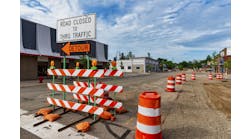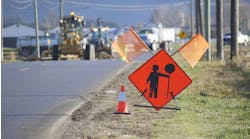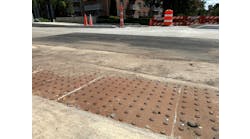The deterioration of the interstate system, due to excessive demand and age, has forced state highway agencies to focus more on the rehabilitation and maintenance of the existing pavements than on the construction of new ones. The effectiveness of various traffic and construction management strategies employed during preservation, rehabilitation and reconstruction of rigid pavements in high-traffic environments is not well understood or supported through current research.
The Federal Highway Administration (FHWA), in collaboration with the Texas Transportation Institute (TTI), recently sponsored a research project titled “Traffic Management Studies for High Volume Roadways” to better identify and document successful traffic- and construction-management strategies used in high-traffic environments. The Lamar Boulevard utilities and reconstruction project in Austin, Texas, was just one of the case studies considered.
Climate control
The Lamar Boulevard utilities and reconstruction project was broad in scope, consisting of road reconstruction, significant water and wastewater improvements and the addition of pedestrian amenities. The project’s physical length was 24 blocks, or 1.7 miles, and was estimated for completion in just over 16 months at a cost of $12.6 million.
Lamar Boulevard is a major five-lane (four lanes plus a turn lane) north-south arterial that parallels North MoPac Expressway to the west and IH-35 to the east. It serves south Austin, downtown Austin and the University of Texas, carrying significant traffic averaging 40,000 vehicles per day.
The project corridor is diverse. Merchants range from small, eclectic retail stores to major grocery stores. The southern end of the project passes through the well-known 6th Street music and entertainment district. Residences along the corridor range from single-family to large university housing and apartment complexes. Proximity to the Capitol and Seton Medical Center supports a number of professional and medical offices. Parks and recreational areas also exist along the corridor.
In addition to the broad scope of the project, its high-traffic, dense urban location and the diversity of needs and impacts along the corridor, the “climate” preceding this project also was unfavorable. More than 40 other city streets were under or planned for construction during the same time frame. Significant utility work at a number of locations was simultaneously under way. The city’s past construction performance had been publicly criticized by the media and, prior to this project’s start, anticipatory media coverage hyped the negative impacts for commuters and merchants, referring to forthcoming “traffic paralysis” and “economic devastation.”
Merchants and residents first
With a number of challenges facing him, the project manager devised a strategy for success. Local merchant and resident satisfaction was made the priority; commuters would have alternative route choices but those that live and work along the corridor would have limited options. This priority was integrated into all aspects of decision-making in the areas of contracting and management, traffic control and management, construction methods and public information—and directly affected the selection of specific strategies employed.
Contracting and management
Potential contractors for the Lamar Boulevard utilities and reconstruction project were held to stricter participation standards than on previous projects. Participating contractors were required to have experience on similarly sized and scoped projects, have demonstrated performance under an accelerated schedule, be able to provide multiple crews, have no existing project backlogs that would interfere with completion of this project and agree to attend daily construction meetings.
The project manager also relied on incentives and disincentives, ranging from $4,000 to $20,000 per day bonus or penalty, to encourage timely or early completion of activities. An additional flat-rate bonus of $120,000 was made available for early or on-time completion of the utilities and reconstruction work along Lamar Boulevard through downtown Austin.
Construction methods
Accelerated curing techniques were used in the mix design. The sequencing of construction activities was flexible to accommodate major merchant events (e.g., annual sales, open houses, charity events). When appropriate, construction activities were scheduled during weekends or at night. Contractors were sensitive to noise in residential areas and routed trucks through commercial areas, temporarily disabled backup alarms (additional inspectors were used to ensure safety) and strategically positioned pump or conveyor trucks near buildings to help mitigate noise in the residential areas.
Traffic control and management
The use of permanent lane closures for traffic control and management proved most successful in reducing overall project duration. Merchants and residents favored more severe closures for shorter periods of time. Despite having developed a formal traffic-control plan for the length of the corridor at the onset of the project, this plan quickly became a “dynamic” document to accommodate changes in construction sequencing. This strategy also proved very successful but required a high familiarity with the corridor and an on-site decision maker to prevent any delays.
Because of the unique focus on merchant and resident satisfaction, additional traffic control and management steps were taken to help ensure access and patronage. Information provided to the motoring public regarding alternative routes was intentionally limited to encourage continued traffic and merchant patronage through the corridor. Merchant access signs were posted and flaggers were used to ensure access for patrons, deliveries and residents. Merchants were additionally allowed to develop their own sign slogans such as “This CD has played three times, and you’ve only moved 22 feet. You’re going to need more CDs. Shop Lamar to encourage continued patronage during construction.” Once approved, the city printed and posted these signs along the corridor.
Public information
A combination of traditional and unique public information methods was used. Traditional methods included news releases distributed through print and broadcast media, a project website and an e-mail distribution list of merchants and neighborhood associations. Unique methods included in-person updates by the contractor at each of the affected merchant/resident sites and weekly on-site merchant/resident meetings attended by both the project engineer and contractor.
Not a total loss
The result of these combined strategies was a resounding success. The project was completed in just over six months, or 10 months ahead of schedule, not only adhering to but dramatically shortening an already accelerated construction schedule. Despite the accelerated schedule, no vehicular, pedestrian or on-the-job incidents occurred throughout its duration. The contractor earned $388,000 in bonuses. Media coverage shifted from unfavorable to favorable and unprecedented public support was observed.
A chronological look at the nature of the media coverage is very telling with respect to the success of this approach. At the onset of the Lamar Boulevard project, initial media coverage focused largely on the loss of revenue for local area businesses: “The business drop-off was instant and severe...,” “Business is off 50% and I can’t make enough to pay the rent at 50%...,” and it was critical of city management: “It’s obvious that city officials failed to properly plan for the problems that drivers are encountering.”
Toward the end of April, merchants became more vocal in their support of the city and contractor efforts: “Though they have much more critical things to be dealing with than the merchants, they have never made us feel that way and I am very grateful for that”; “E-mail updates have allowed me to keep all my members aware of the traffic constraints and they have sent many appreciative e-mails to me. Different members of the team have personally visited my business no less than five times just to let me know what is going on and make sure we are aware. The extra efforts they have made have not gone unnoticed and I cannot thank them enough for their attention.”
Local merchants hosted a tented appreciation lunch for workers. Merchants were still reporting a loss in revenue but placed no fault with the city or contractor: “We have had a huge decrease in sales. Don’t get me wrong, this was unavoidable; we could not have asked for more in the construction.” One merchant suggested that the responsibility lies with their customers to accommodate the construction activities: “If people want to come down here, they can make it a point to navigate construction. They [the contractors] have let us know when there will be a disruption a week in advance.”
A month later, media coverage shifted to wholehearted merchant support of the city and contractor efforts with no mention of revenue loss: “It’s been amazing. By being included we felt empowered and have an ownership in this project. They presented us with options. They told us they could do this real fast and it will hurt a little, or they could methodically do the work and the pain would be longer. We were given a choice.
“The contractor and the city have been great about communicating with us. This should be a model of how the city needs to do projects from now on.”
The power of partnership
Several key factors made this project a success. At the onset, a nontraditional priority for local merchant and resident satisfaction was set, embraced by all team members and integrated into all aspects of decision making.
Contracting and management strategies included daily construction meetings attended by all decision makers, strict contractor participation standards and incentives and disincentives. Construction methods utilized accelerated mix designs, flexible sequencing of activities, off-peak construction and noise abatement strategies.
Traffic control and management strategies included permanent closures, a dynamic traffic-control plan and various unique access/patronage strategies. Public information strategies included a combination of mediums and weekly on-site merchant/resident meetings.
Integral to the success of these combined strategies used in the Lamar Boulevard utilities and reconstruction project was the close partnership that was effectively developed between the city project manager and engineers, the contractor and the local merchants/residents.


